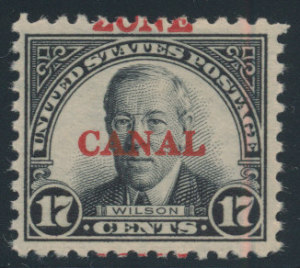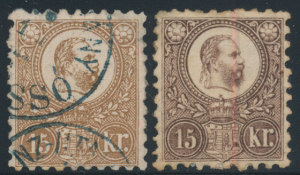The most basic decision that most collectors make is whether to collect stamps mint or used. In the very earliest stages of collecting either will do and, at the very highest stages, finances often force either to do. But most collectors start saving both and then gravitate to one or the other. The decision comes down to a calculation. Used stamps are usually cheaper and require less care in mounting and handling. If I were putting away stamps long term for an investment portfolio I would only select used as with mint stamps gum grading standards have changed dramatically over the years and are likely to do so further in the future. Gum can degrade over time if not stored carefully and even the smallest amount of humidity can cause toning. Since so much of the value of a mint stamp today is in perfect gum I wouldn't want to have to worry about this as a long term investment. Used stamps are easy to store and harder to damage. You probably shouldn't try this at home but if you ever have in
Monthly Archives: March 2021
- Posted March 31, 2021in NewsRead more »
- Posted March 27, 2021in NewsRead more »
Of the major world wide powers in the philately era (that is since 1840) the least imperialistic has been the United States. Great Britain and France had between them hundreds of imperial philatelic entities. German was a big player and even Italy, which had more of an appetite for conquest than the digestion, had fifty or more imperial philatelic areas for which she issued stamps. Partly because our own internal markets were so large, partly because of immigration, partly because of endless land to be developed and maybe a bit because of our democratic aspirations, America was a far smaller player in the Imperial game than our European competitors. This changed a bit in the late Nineteenth Century when the Spanish American war gave America three colonies - the Philippines, Cuba and Puerto Rico. These colonies were largely not-for- profit imperial ventures. Two other colonies were more commercial and trade driven-the Canal Zone and the Danish West Indies. A canal through the Isthmus of P
- Posted March 24, 2021in NewsRead more »
If philately were an academic discipline, there would be several basic elements of understanding that stamp majors would have to master before moving to graduate level courses. High on this list would be a basic understanding of printing methods. There are many methods of transferring ink from plate to paper (and, now, even the word "plate" is far too restrictive for what amounts to a high speed ink spraying process that looks to the paper receiving it more like a car wash than a printing process), but the major printing processes all boil down to two major types-engraving, where ink is squeezed from recessed lines on the plate onto the paper, and litho-typography, in which a flat layer of ink is pressed onto the sheet.
Engraving was the preferred method of printing stamps in the early days of philately as it was a far harder process for counterfeiters to imitate convincingly. But the major te - Posted March 17, 2021in NewsRead more »
The German area, as collected by the Michel catalog is the most diverse and complicated collecting area in the world. The Michel Germany specialized catalog and the Gansachen (that is postal stationery catalogs) of German and the German Area run nearly 4000 pages and list and price nearly one million stamps and specialty pieces. A complete Germany collection has never been made and rarely even attempted. Germany dwarfs in complexity British Commonwealth and French Community collecting and rivals in complexity United States philately, though Germany far exceeds US in scope. The reasons are two. First, Germany's complex political history has created far more philatelic entities than any other philatelic specialty. There are the component States that confederated in 1870 to form modern Germany. There are the war induced issues of WW I and WW II, post war allied and Soviet occupation issues, Colonies and more. The second reason that German area philately is so vast is that the Germans have s
- Posted March 13, 2021in NewsRead more »
Collectors of United States stamps in the 1920-1950 period had a dilemma. The days of varieties were gone. The papers and printings of the Bank Note issues which span over 80 major Scott numbers were over as were the wild early days of the Washington-Franklins that spawned nearly 200 major numbers. Stamp issuing policy was conservative and the definitive set of the period-the Presidentials- had few varieties. Stamp collectors need new issues and less expensive stamps to add to their collection or they lose interest. So American collectors gravitated to plate blocks. It's not that other countries lacked marginal markings-both German and British stamps have plate numbers and French stamps have marginal numbers called millesimes- it is just that plate block collecting caught on in the United States to satisfy this desire for more newer issues to collect.
The reason why Americans esteem their marginal - Posted March 10, 2021in NewsRead more »
The biggest mistake newer dealers make is the inventory trap. They go out, buy some stamps and begin to resell them. Generally, they get very good prices for some of the things that they offer ("very good" defined as far more than they expected), good prices for some material, weaker prices for more and no prices (that is, no sale)for the rest. This is par for the course, but it is what a dealer does here that determines success. Most dealers add up what has sold and add up the inventory that is left (reducing the value by the margin they made on the sold material) and figure that they made a profit if that amount is greater than the cost of goods minus selling expenses. The problem with this method is that it tends to greatly overvalue the unsold portion of your inventory. Despite all your rationalizations the main reason that material you offer doesn't sell is that it is unpopular or overpriced or both. Such material is saleable but it will need to marked down. And it is in handling ma
- Posted March 07, 2021in NewsRead more »
Granted, last year was very different regarding Americans moving traveling around, but on average over 150 billion gallons of gasoline would be consumed in the United States within a 'normal' year. That works out to about 500 gallons for each person living in this country. At a national fleet average of twenty miles a gallon the average American drives 20000 miles per year though this is skewed by truck usage which stocks our shops and factories though it is not technically individual transportation. Most driving is not discretionary. We drive to work and school and to run the errands we need to do to live our lives. It is in our free time, our hobbies that we have the ability to determine whether we will have a low environmental impact hobby or not. There are few hobbies or interests that are more environmentally kind than philately. Even golf requires a drive to the course and bikers often put their bikes on racks and drive miles to get the perfect ride. Now that few collectors go to
- Posted March 03, 2021in NewsRead more »
There are several factors to take into account when evaluating the challenge of collecting any given country. First, how difficult is the country to complete using the major catalog for that country. Second, how pricey is the material from that country? How much will it cost to complete (or at least make a strong representative collection). Third, price aside, how available are the more unusual and scarce items from the country. And fourth, how much philatelic knowledge is needed to collect and appreciate the stamps of the country.
By all these measures the most difficult country to collect in the world is the stamps of the United States. First, there are more rarities among the major numbers of the United States than any other country. Many of the Special Printings exist is quantities of only a few hundred or less and of #5 there are less than fifty copies. Second, because of its popularity, th


